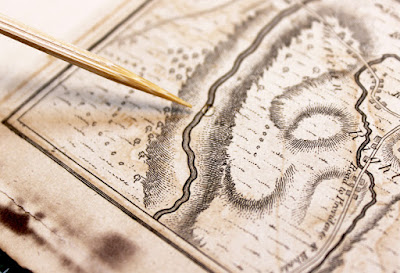 |
| Black printing ink created a brownish mirror image on the facing page as the acidity leached from one page to the next. |
Book and Paper Conservators have various treatment methods for removing or reducing the harmful effects of pollutants from paper, such as surface cleaning, deacidification, and aqueous treatment. Aqueous treatment is most often described as the process of cleaning and deacidifying paper by submerging it in a bath of water, or a series of baths. Depending on the item being treated, each bath may last from about fifteen minutes to more than an hour. After each bath, the item being treated is removed from the bath and the dirty water is emptied and replaced with clean water. This process continues until the bath water runs clear or almost clear after soaking. Aqueous treatment reduces the acidity of the paper somewhat, often reduces the discoloration caused by age or environmental exposure, and helps remove some of the dirt and grime from the paper. It can also be a great method for removing some types of tape and adhesives from previous repairs like paper tapes.
 |
| Map of Boston from The Life of George Washington, 1807. |
 |
| Two layers of paper tape were attached to the folded edge of the map. |
This map of Boston is from The Life of George Washington, 1807, and was at one time attached in the book with paper tape or else mended with paper tape at some point. Paper tape often has a water-soluble adhesive, so aqueous treatment is an effective way to remove it, provided the paper can be submerged in a bath of water. Sometimes the paper is too fragile to withstand aqueous treatment or it might contain media, such as ink or watercolor, that is soluble in water, which prevents a conservator from using an aqueous treatment. For that reason, the media must first be tested for solubility. If it is stable, aqueous treatment can proceed.
 |
| Water droplet applied to ink to test for solubility. |
 | |
| A small piece of blotter was used to absorb the water droplet and determine if the media was stable. |
 | |
| The blotter was clean, as seen above, so the media was stable and aqueous treatment could proceed. |
Once the media for this map was tested, the map was placed on a piece of Hollytex. Hollytex is a thin, strong, acid-free, woven polyester that acts as a support while the paper is in the water bath. A second sheet was placed on top so that the map was sandwiched between and it was easier and safer to handle.
 |
| Map resting on Hollytex prior to humidification |
Before placing the map in the water bath, it was humidified lightly to help it absorb water more easily once submerged. A Dahlia Sprayer - commonly used in conservation, was imported from Japan, and was selected for its ability to provide a fine mist without droplets or splatters - was used to humidify the front and back of the page prior to submersion.
 |
| The water flow was tested prior to misting the map. |
 |
| The back of the map was also sprayed prior to submersion in the water bath. |
Once the map was humidified and the fibers were relaxed, the second piece of Hollytex was placed on top and the map was carefully submerged into a bath of water. Light pressure was applied to encourage the map to absorb water and sink into the bath for soaking.
 |
| The map, sandwiched between two pieces of Hollytex, was submerged into a bath of water. |
 |
| Light pressure was applied to encourage the map to absorb water and sink into the bath. |
 | |||
| The map was left to soak so that the paper tape's adhesive could dissolve and release. |
 |
| The paper tape |
After soaking for about a half hour, the adhesive from the paper tape had softened enough to release from the map. The paper tape was peeled back to the extent possible, then a microspatula and a larger plastic spatula were both used to loosen and lift the remainder of the paper tape carrier.
Once both layers of the paper tape were removed, the surface of the map where the tape was adhered was lightly massaged to remove any remaining adhesive.
 |
| Using fingertips to gently massage the paper surface to remove the remaining adhesive. |
The map was then soaked in several successive baths to remove acidity and discoloration to the extent possible.
 |
| When tilted, it was easier to see how discolored the water had become. |
After the last bath, the map was removed from the bath and placed on a blotter to air dry. Sometimes, paper items will need flattening after washing, but fortunately this map dried flat on its own.
 |
| The Hollytex makes it much easier to handle the wet paper. |
 |
| Draining the majority of the water out before placing on blotter. |
 |
| Wet map drying between Hollytex on blotter. |
The map will be mended and hinged back into its place in The Life of George Washington with Japanese paper and starch paste. Because it was washed, much of the acidity has been removed, so it will be stronger and hopefully be used for many years to come.



No comments:
Post a Comment